Tercera Federación is a hub of talent in Spain.
This is not only true of talent but also of the tactics within the tournament for every single team.
In a country where positional play abounds and space management is usually similar, the differences in the styles of play in these categories are easy to detect.
There are three youth teams from LaLiga clubs in Tercera RFEF, Group 7 (Madrid).
Even teams like RSD Alcalá or Alcorcón B are constantly trying to recover high, fast and playing with a proactive style.
In that sense, one of the rarest stories this season is that of Aravaca.
Miguel Madrid, the head coach—alongside Jorge Beamonte, Miguel Martínez, and Enrique Forment on the technical staff—has developed his team using a more reactive philosophy and exploiting some of Aravaca’s specific strengths.
In this tactical analysis, including an interview with head coach Miguel Madrid, we will dive into Aravaca’s throw-in tactics, the resources that they possess to become strong in that topic, and the training methodology that he applies to become better in set-piece actions.
Aravaca’s Context In Tercera Federación
With positional play abundant, Miguel Madrid’s Aravaca—recently promoted from the Autonómica category—are trying to become strong in duels, velocity, and set-piece actions at home.
Why at home? Well, Aravaca’s stadium is one of the smallest in the tournament.
That is the main reason for consolidating a more reactive style of play than other teams.
“We want to bring them into our game at our home—a physical style full of duels, pace, and high intensity.
Some teams come in and stick to their possession-based approach.
That’s when we try to steal the ball back as quickly and as high up the pitch as possible because our defenders know how to cover space.
That’s when we press.
In the second half, there are moments where they dominate, and we drop into a mid-to-low block to try and hit them on the counter with our wide players,” Madrid told us after asking about the impact of Aravaca’s home and the style of play that they want to have there.
Other teams have technically privileged players, whereas Aravaca are stronger in physical terms.
The rhythm of the game is crucial in that sense.
“(On Aravaca’s current game model) We can’t score a goal with 20-25 touches on the ball.
We try to handle possession well, but if we can score in two touches, that’s great—and if it takes six or eight, that’s fine, too.
Playing out from the back is tricky because of the dimensions of the pitch.
We can play short, maybe once out of every five goal kicks; the rest go long to try to win aerial duels and second balls.
Once in the opponent’s half, we link up with the centre-backs or midfielders.”
How Does A Non-Youth Team In Tercera Federación Organise Their Training Sessions?
Madrid explains their weekly work to help understand Aravaca’s training routine.
“We train three days a week.
On Tuesdays, we focus on physical work and introduce tactical concepts on a macro level.
Due to facility limitations, we can’t train for four days.
Thursdays are for tactical work across the whole pitch: passing drills, technical shapes, and tactics (attack and defence, with more emphasis on defence on Thursdays).
We also dedicate the last part of the session (15-30 minutes) to set pieces.
On Fridays, we focus heavily on finishing, combination plays, tactical review, and watching video analysis of the opponent.”
How Do Aravaca Train The Offensive Set-Piece Actions?
With a lot of time and theory behind the scenes, Aravaca use pre-rehearsed movements and formations in the opposition’s box.
Interestingly, their offensive set-piece actions include corners, indirect free-kicks, and throw-ins in the rival’s half.
So, Madrid and his coaches think set-piece actions are crucial to deciding matches.
He explains the process that he employs with the team to study and prepare the offensive set-piece actions.
Aravaca’s training plan on this topic is divided into three phases.
“Set pieces are key.
We need to improve in that area, especially since we have a specialist for throw-ins.
Then there are free kicks and corners as well.
At the start of the season, we work on them analytically without opposition, focusing on positioning in the initial zones and drop zones, using screens and decoy movements.
Once we’ve mastered the analytical phase, we move to an integrated approach.
At first, the initial touch is free, and then the defence becomes semi-active or semi-passive.
From there, we progress to active defending, focusing on the second ball, drop zones, and other details.”
Analytical and integrated are the first two phases of the training sessions.
There, Aravaca’s players get prepared for the most realistic phase: the competitive stage.
Madrid gave us an example with corners.
“For corners, we start analytically and finish integrated, but we don’t load up with too many defenders.
We want the players to score and execute the play visibly.
Instead of defending with six players, we defend with four and use two mannequins, giving the numerical advantage to the attackers.
From the integrated phase, we transition to a competitive setup where the losing team might have to treat everyone to refreshments that week, for example, adding a competitive stimulus to take it seriously during the training.
Making it competitive helps boost intensity.
Throughout the year, I like to review set pieces twice a month. When we face matches where set pieces are critical, we are willing to dedicate three weeks to fine-tuning them if necessary.”
Let’s illustrate this training methodology.
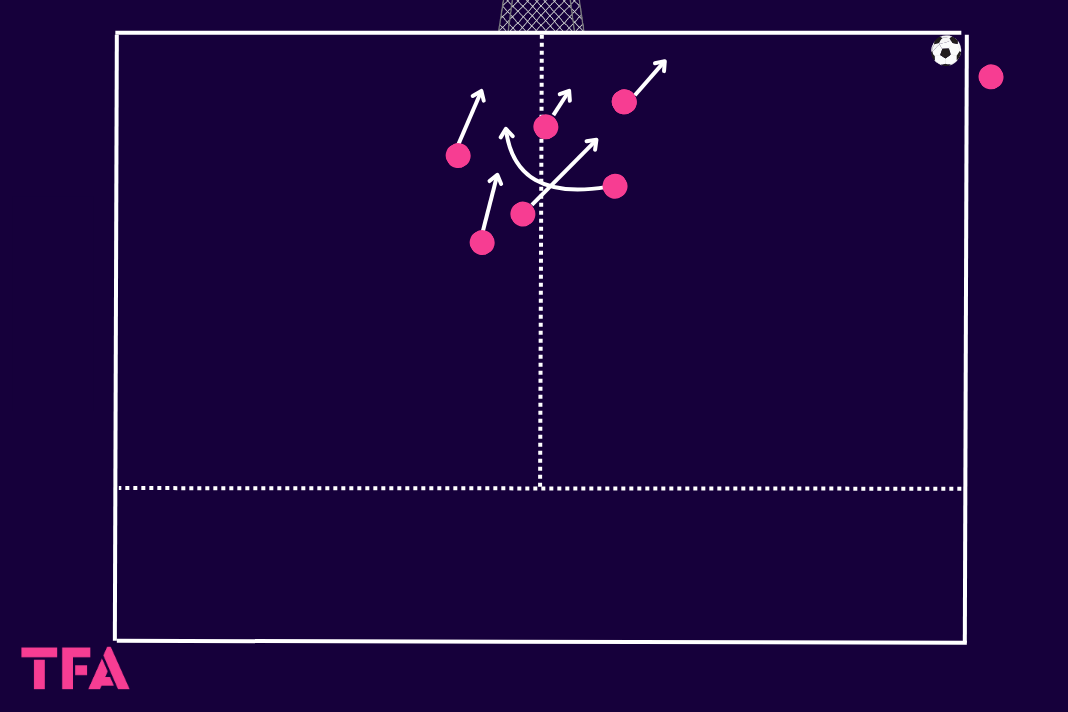
In Figure 1, there are no defenders, and after studying and understanding the positions, the players recognise the signals and the potential movements.
In terms of the analytical aspect, players’ stimuli during the session are only the designated zones for understanding the potential plays that they can execute in a future match.
Then, the integrated phase.
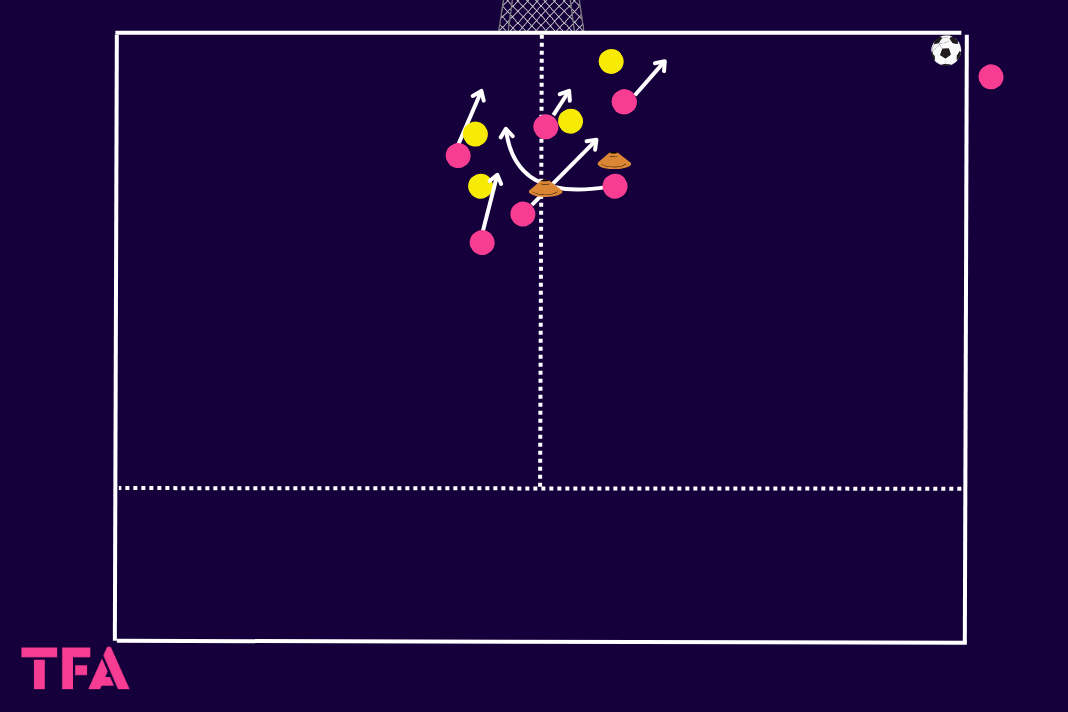
Here, as Figure 2 shows, there are two mannequins and the attackers get an advantage.
The first touch is also free.
In the integrated phase, the stimuli increase a bit, and the players recognise where the rivals (zonal or man-to-man, depending on the opposition analysis) are potentially going to be, but the intensity is not high.
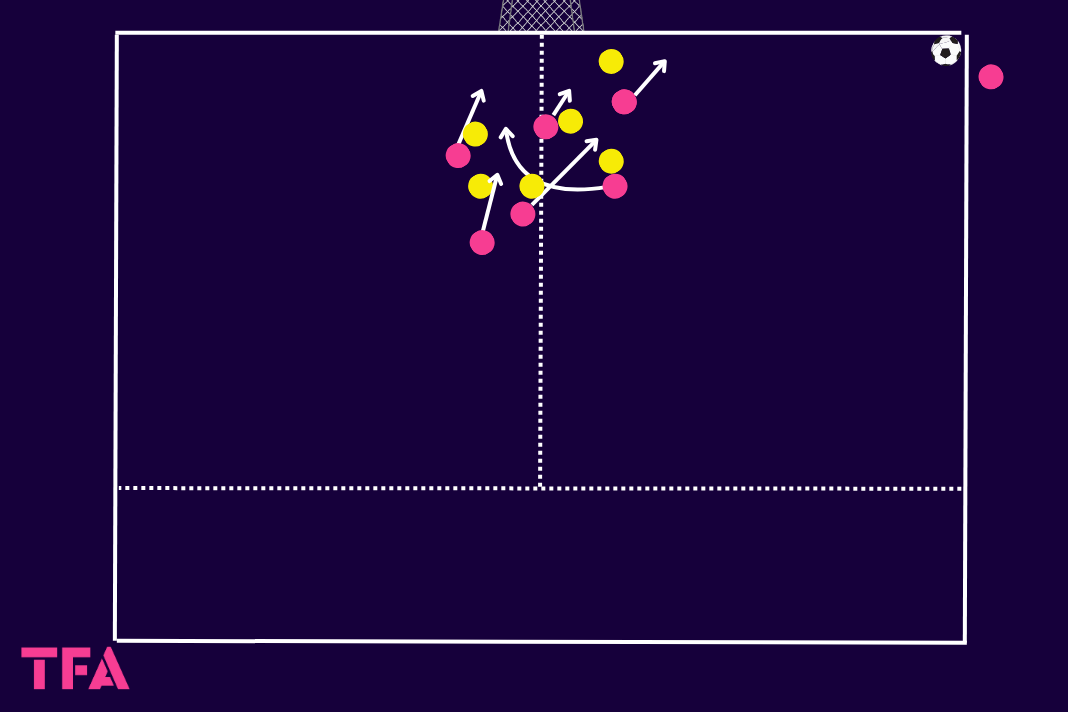
Finally, the competitive phase is the most realistic one.
The players already understand the positions they should be occupying in each play and have some ideas about how their marker will try to chase him and win the duel.
Even with a competitive stimulus, the weekend is major proof.
This is where Aravaca have shone.
The Throw-Ins And Aravaca’s Specialist, Alberto Martín
Aravaca’s left-back, Alberto Martín, is one of the best throw-in specialists in their division.
With this approach, Madrid must try to exploit the areas in which he has better weapons than other teams—and this is one of the main ones.
With the physical biotype of a centre-back in his body composition, his technique and power give him a long throw-in range.
Especially at home, Aravaca use this skill as a way to progress and attack.
Let’s see the first clip of this piece to take a look at Alberto Martín long throw-in range.
pic.twitter.com/a2z0rEB32r
— Footie Clips (@FootieClips) December 26, 2024
Here, there are a few interesting details.
The first one is that now you see Martín’s range in throw-in actions.
The second one is that he went from the left-back position to take a throw-in.
Aravaca prepare their rest defence in these types of actions as if it were a corner, and the players have prepared formations.
In this video, they looked for the player at the first post and a second ball to the centre, although it did not work in this case.
However, think about how many opportunities to execute these ideas during the whole match they have week by week.
Defending these actions like a corner is complex, and Miguel Madrid explains the difference between both.
“The difference between a throw-in and a corner is that you have more precision with your hand than with your foot.
You can place the ball exactly where you want it, and Alberto is great at doing just that.
Repetition helps the players know exactly where the ball is going to land.
It’s all about greater accuracy.
While the ball doesn’t travel as fast as it would from a kick, it can carry a favourable trajectory depending on the play we’re aiming for.”
This ability is an advantage to score; we will see it in the upcoming goal against Villalba.
pic.twitter.com/bNDnCpqDGu
— Footie Clips (@FootieClips) December 26, 2024
In this goal, Aravaca used various screens and coy movements focusing on the first post, and Martín’s remarkable accuracy and range generated a goal.
Villalba’s defenders did not expect the ball to get to the far post, and they were dragged by the players, making dismarking runs to the near post.
Using Throw-Ins As A Way To Progress
This ability is not only a way to get direct goal opportunities.
Martín’s throw-in range can also be used for beating lines of pressure and trying to win aerial duels forward or second balls.
Look at the example below.
pic.twitter.com/CmSRtAnbCi
— Footie Clips (@FootieClips) December 26, 2024
In this video, Martín could prepare a direct offensive throw-in, taking three steps forward.
Still, he detected an opportunity to progress quickly and beat the pressure—the same pressure that initially caused him to lose the ball.
And there, with players like Álvaro Pérez as the centre-forward for winning a high volume of aerial duels and very physical midfielders to prolong the play, Aravaca get another opportunity to use their throw-in specialist as a tactical advantage.
Conclusion
The smaller pitch is a determining factor here—fewer metres equal more progress—so this is a lesson on how to exploit specific strengths within a tournament decided by small details.
A recently promoted team in Tercera RFEF are trying to take advantage of every specific skill that they have in their squad, and the set-piece actions are one of them.
With positional play being the usual philosophy in this category, even applying a positional model at the moment of defending and using spaces in attack, in possession, Aravaca are strong in direct play and must use their main determining factor in their favour: Antonio Sanfiz Stadium.
Only training three days per week, they have competed against youth teams from first-division clubs during the first half of the season, having been in Autonómica a season ago.
Now, the aim is to stay in the division!

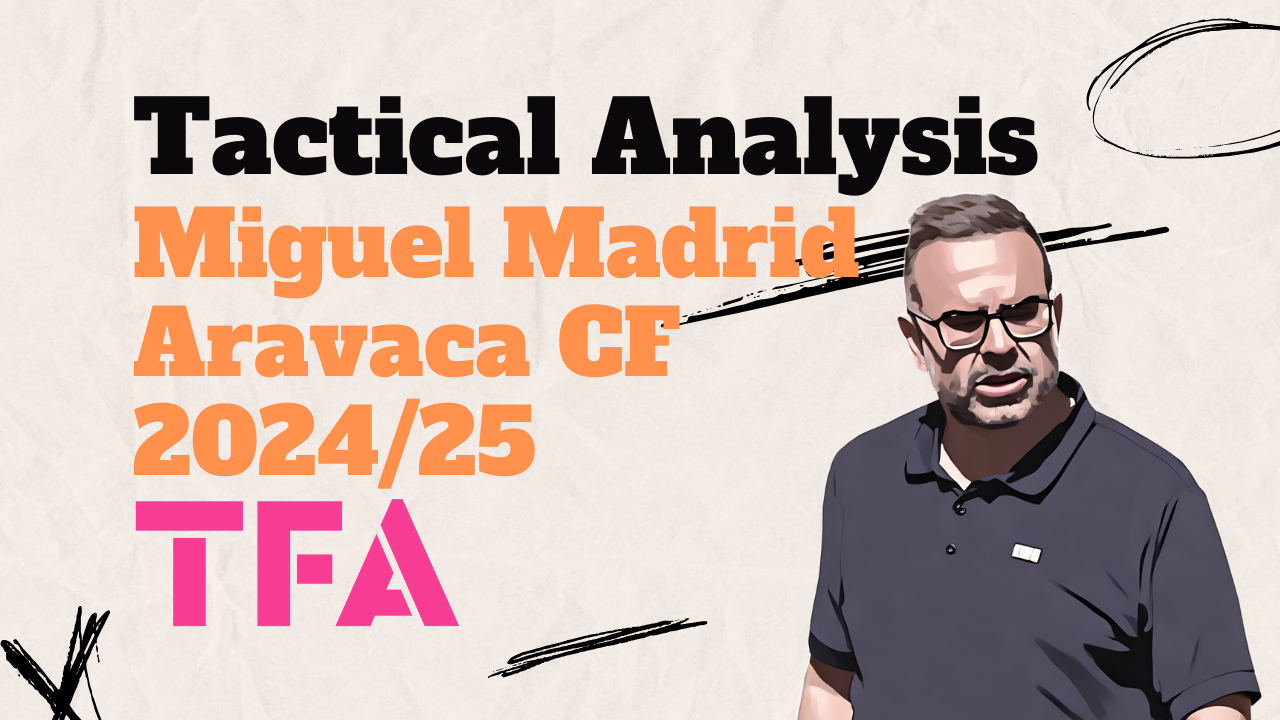
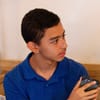



Comments